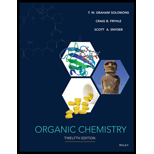
ORGANIC CHEM. VOL.1+2-W/WILEYPLUS
12th Edition
ISBN: 9781119304241
Author: Solomons
Publisher: WILEY C
expand_more
expand_more
format_list_bulleted
Concept explainers
Question
Chapter 1, Problem 9PP
Interpretation Introduction
Interpretation:
The Lewis structure for the phosphate ion
Concept introduction:
The Lewis structure of a molecule is therepresentation of the molecule in which the valence electrons of the atomsare shown.
The number of valence electrons of an atom is equal to the group number to which it belongs. Bonding atoms attaina stable electronic configuration and a stable atom generally has eight electrons in itsvalence shell.
To attain a stable configuration, atoms share their electrons with each other,
Expert Solution & Answer
Want to see the full answer?
Check out a sample textbook solution
Students have asked these similar questions
The reaction Q(g) + R(g) → Z(l) is shown to be exothermic. Which of the following is true concerning the reaction.
it is spontaneous only at High T, it is spontaneous at low T
it is nonspontaneous at all T
it is spontanrous at all T.
it is non spontaneous only at low T.
The reaction Q(g) + R(g) → Z(l) is shown to be exothermic. Which of the following is true concerning the reaction
Which of the following has the largest standard molar entropy, S° (298.15 K)
He
H2
NaCl
KBr
Hg
Chapter 1 Solutions
ORGANIC CHEM. VOL.1+2-W/WILEYPLUS
Ch. 1 - Prob. 1PPCh. 1 - Prob. 2PPCh. 1 - Prob. 3PPCh. 1 - Prob. 4PPCh. 1 - Prob. 5PPCh. 1 - Prob. 6PPCh. 1 - Prob. 7PPCh. 1 - Prob. 8PPCh. 1 - Prob. 9PPCh. 1 - Prob. 10PP
Ch. 1 - Prob. 11PPCh. 1 - Prob. 12PPCh. 1 - Prob. 13PPCh. 1 - Prob. 14PPCh. 1 - Prob. 15PPCh. 1 - Prob. 16PPCh. 1 - Prob. 17PPCh. 1 - Prob. 18PPCh. 1 - Prob. 19PPCh. 1 - Prob. 20PPCh. 1 - Prob. 21PPCh. 1 - Practice Problem 1.22 Which of the following...Ch. 1 - Prob. 23PPCh. 1 - Prob. 24PPCh. 1 - Practice Problem 1.25
What do the bond angles of...Ch. 1 - Prob. 26PPCh. 1 - Practice Problem 1.27
Use VSEPR theory to predict...Ch. 1 - Practice Problem 1.28 Predict the bond angles of...Ch. 1 - 1.29 Which of the following ions possess the...Ch. 1 - 1.30 Write a Lewis structure for each of the...Ch. 1 - Prob. 31PCh. 1 - Add any unshared electrons to give each element an...Ch. 1 - Prob. 33PCh. 1 - What is the molecular formula for each of the...Ch. 1 - Prob. 35PCh. 1 - Prob. 36PCh. 1 - 1.37 Write bond-line formulas for all of the...Ch. 1 - Prob. 38PCh. 1 - Prob. 39PCh. 1 - Prob. 40PCh. 1 - Prob. 41PCh. 1 - (a) Cyanic acid (HOCN) and isocyanic acid (HN=C=O)...Ch. 1 - Consider a chemical species (either a molecule or...Ch. 1 - 1.44 Consider a chemical species like the one in...Ch. 1 - 1.45 Consider another chemical species like the...Ch. 1 - Draw a three-dimensional orbital representation...Ch. 1 - Ozone (O3) is found in the upper atmosphere where...Ch. 1 - Write resonance structures for the azide ion, N3....Ch. 1 - Write structural formulas of the type indicated:...Ch. 1 - Prob. 50PCh. 1 - 1.51 In Chapter 15 we shall learn how the...Ch. 1 - Prob. 52PCh. 1 - (a) Consider a carbon atom in its ground state....Ch. 1 - Open computer molecular models for dimethyl ether,...Ch. 1 - Boron is a group IIIA element. Open the molecular...Ch. 1 - 1.56 There are two contributing resonance...Ch. 1 - Prob. 1LGPCh. 1 - Consider the compound with the following condensed...Ch. 1 - Consider the compound with the following condensed...Ch. 1 - Consider the compound with the following condensed...Ch. 1 - Consider the compound with the following condensed...Ch. 1 - Consider the compound with the following condensed...Ch. 1 - Prob. 7LGPCh. 1 - Prob. 8LGP
Knowledge Booster
Learn more about
Need a deep-dive on the concept behind this application? Look no further. Learn more about this topic, chemistry and related others by exploring similar questions and additional content below.Similar questions
- Which of the following is true for a particular reaction if ∆G° is -40.0 kJ/mol at 290 K and –20.0 kJ/mol at 390 K?arrow_forwardWhat is the major product of the following reaction? O O OH OH 1. BH 2. H₂O₂, NaOH OH OHarrow_forwardDraw the products formed when each ester is hydrolyzed with water and sulfuric acid.arrow_forward
- Draw the products of the hydrolysis reaction between the ester molecule and water. Determine the products of the following reaction.arrow_forwardWhat is the unsaturation number for compounds with the formula C₂H₁₂Cl₂? O õ õ o o 4 3arrow_forwardIndicate the product obtained (formula). F3C. CF3 Br NH2 NH OMe K2CO3, DABCO, DMFarrow_forward
arrow_back_ios
SEE MORE QUESTIONS
arrow_forward_ios
Recommended textbooks for you
 Introduction to General, Organic and BiochemistryChemistryISBN:9781285869759Author:Frederick A. Bettelheim, William H. Brown, Mary K. Campbell, Shawn O. Farrell, Omar TorresPublisher:Cengage Learning
Introduction to General, Organic and BiochemistryChemistryISBN:9781285869759Author:Frederick A. Bettelheim, William H. Brown, Mary K. Campbell, Shawn O. Farrell, Omar TorresPublisher:Cengage Learning

Introduction to General, Organic and Biochemistry
Chemistry
ISBN:9781285869759
Author:Frederick A. Bettelheim, William H. Brown, Mary K. Campbell, Shawn O. Farrell, Omar Torres
Publisher:Cengage Learning